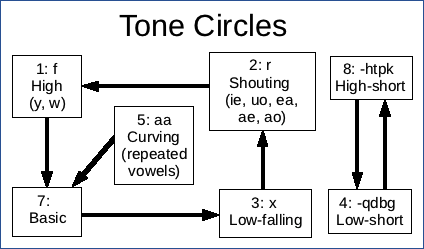Tone sandhi: Difference between revisions
Jump to navigation
Jump to search
No edit summary |
|||
| Line 1: | Line 1: | ||
'''Tone change''' ({{w|tone sandhi}}) in [[Taigie|Taiwanese]] is the process of altering the [[Tones of Taiwanese|tone]] of a syllable depending on the surrounding words and grammatical function. Most nouns in Taiwanese do not change tone. However, almost all verbs and adjectives do change tone when not at the end of a phrase. | '''Tone change''' ({{w|tone sandhi}}) in [[Taigie|Taiwanese]] is the process of altering the [[Tones of Taiwanese|tone]] of a syllable depending on the surrounding words and grammatical function. Most nouns in Taiwanese do not change tone. However, almost all verbs and adjectives do change tone when not at the end of a phrase. | ||
==Basic rules (Tone | == Basic rules (Tone Circles) == | ||
[[File:Tone | [[File:Tone Circles.png|right|frame|Taiwanese tones in isolation, and the changes they undergo when they precede another tone.]] | ||
* If the original tone number is '''5''' ([[curving-up tone]]), pronounce it as tone number '''7''' (basic). | * If the original tone number is '''5''' ([[curving-up tone]]), pronounce it as tone number '''7''' (basic). | ||
* If the original tone number is '''7''' ([[basic tone]]), pronounce it as tone number '''3''' (low-falling). | * If the original tone number is '''7''' ([[basic tone]]), pronounce it as tone number '''3''' (low-falling). | ||
* If the original tone number is '''3''' ([[low tone|low-falling]]), pronounce it as tone number '''2''' (shouting out). | * If the original tone number is '''3''' ([[low tone|low-falling]]), pronounce it as tone number '''2''' (shouting out). | ||
Revision as of 23:08, 25 August 2019
Tone change (tone sandhi) in Taiwanese is the process of altering the tone of a syllable depending on the surrounding words and grammatical function. Most nouns in Taiwanese do not change tone. However, almost all verbs and adjectives do change tone when not at the end of a phrase.
Basic rules (Tone Circles)
- If the original tone number is 5 (curving-up tone), pronounce it as tone number 7 (basic).
- If the original tone number is 7 (basic tone), pronounce it as tone number 3 (low-falling).
- If the original tone number is 3 (low-falling), pronounce it as tone number 2 (shouting out).
- If the original tone number is 2 (shouting tone), pronounce it as tone number 1 (high).
- If the original tone number is 1 (high tone), pronounce it as tone number 7 (basic).
- If the original tone number is 8 (high-short), pronounce it as tone number 4 (low-short).
- If the original tone number is 4 (low-short), pronounce it as tone number 8 (high-short).
See Taiwanese Hokkien#Tone sandhi for a more detailed explanation.
Examples
- køf + hioong = Køhioong
- tvar + kao = Tvafkao
- baq + zaxng = bahzaxng
- Taai + oaan = Taioaan
- bak + ciw = bagciw
Exceptions
- most nouns
- ciaf, hiaf, zef, hef, ciahniq', hiahniq'
- symmih, ui symmih, (see Taiguo_Siong'iong_460-ji#Demonstrative_pronouns)
- basic tone + ar. (The basic tone syllable is excepted).
- surnames before siensvy: Taan`siensvy
Further details
- more detailed rules have been posted at Wikipedia: Taiwanese Hokkien#Tone sandhi, esp. special cases involving suffix ar (仔) and triplication
- syllables ending in "h" are usually pronounced in shouting tone, such as in bahzaxng, but not beq
- khix ("to go") is usually treated as if originally "khiq"
